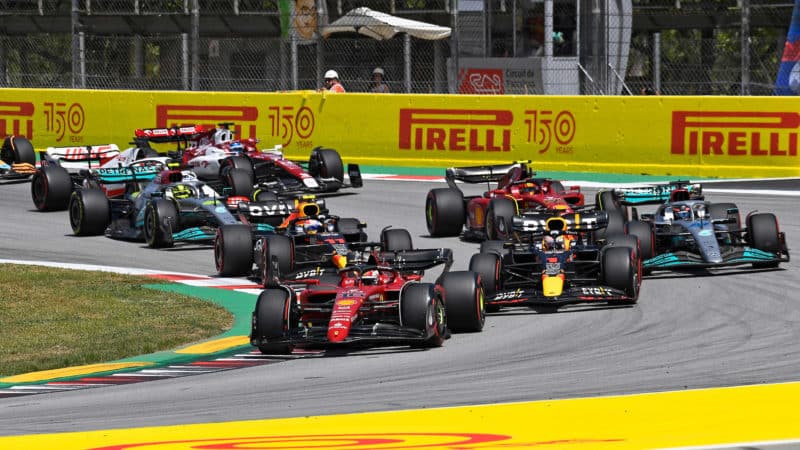Formula 1 says it will be net carbon zero by 2030, and I’m going to give it the benefit of the doubt by stating it surely is taking the impact of the calendar expansion into account when trying to reach those targets. It’s one thing trying to reduce your impact from a stable position and finding it a challenge to get there, it’s another to fail because you actually went the opposite way in some aspects.
And achieving net zero by actually increasing your emissions but then offsetting more as a result is not really the approach to take.
I say this because logistics – defined as “All road, air or sea logistics across the sport including the movement of teams equipment, F1 equipment, Paddock Club equipment and race tyres” – made up 45% of the sport’s carbon footprint back in 2019, the biggest area by far.
As pointed out above, there were 21 races that led to that percentage back in 2019, there will 24 races four years later, an increase of nearly 15%. And the current calendar includes back-to-backs of Baku and Miami, Las Vegas and Abu Dhabi, plus standalone trips to Bahrain, Saudi Arabia, China and Australia. Oh, and a triple-header of USA–Mexico–Brazil for good measure.
If you go from one venue to the next without ever returning home, you will cover more than 80,000 miles next season, more than three times the earth’s circumference. It doesn’t take a genius to work out that’s going to be a heck of a lot higher for traveling personnel even if equipment can follow the point-to-point route.
Of course, F1 had thought of its people – or at least claimed to – when it changed the race weekend format. Squeezing everything into three days rather than four was designed to reduce the amount of time people had to be away from home (or at least on site), slightly lessening the strains of the extra races being added.
If you were asked to work 20% more time, would you automatically say yes?
But in reality, that schedule change only served to allow F1 to move the session times later, particularly on a Friday to be able to make use of a late qualifying session during sprint weekends and potentially get more eyeballs on practice. When it became clear that it made for long, tough days at the start of the weekend (that provided very little media value as pointed out to F1 and the FIA both before the schedule was adopted and afterwards) then that decision was reversed and many aspects returned to the previous set-up.
If you work for a team, your time away from home has not reduced, even if the spread of hours during a race weekend has been improved. And, as I have written about in the past, if you’ve reached the very top in F1 and are deemed indispensable by your team, you’re going to be required trackside as much as possible. So a bigger calendar just means even greater commitment.
Plenty of team members know the sacrifices they are going to have to make when they get into F1, but if they joined in 2017 – only five years ago – they are being asked to commit to a calendar that has expanded by 20%. However much you love your job, if you were asked to work 20% more time, would you automatically say yes?

F1 will fly the equivalent of over three times round the world in 2023
Getty Images
F1’s definitely creeping closer to some form of breaking point, and I’m not just talking about for those working in it. It’s easy for me to think of things from my own perspective (I still view the problems it creates for me to be good ones, even if setting a wedding date has become almost impossible when you try and pair availability with the calendar…) but fans have similarly considerations.
I know that many of you reading this will want to watch both qualifying and the race on any given grand prix weekend, impacting both a Saturday and a Sunday. More races is great from an entertainment perspective, but that’s now 48 of the 104 weekend days per year (should you work weekdays only – an increasingly rare situation I’ll admit) that F1 will have an impact. Either it will mean having to miss some of the action you want to watch, or sacrificing other plans.
So I thought I’d get a bit of a snapshot of fan sentiment from Twitter. I think it’s safe to say the majority of my followers identify as F1 fans in some way, shape or form – even my Mum – and at the time of writing, from nearly 13,000 votes, 28.4% think the calendar looks good, but 55.8% feel it has too many races. Only 5.4% feel there are not enough.
What are your thoughts on the 24-race 2023 calendar?
Not an exhaustive list, add your comments below too 👇 #F1
— Chris Medland (@ChrisMedlandF1) September 20, 2022
Surely you want to leave people wanting more. If there’s a risk that fans are starting to become apathetic towards the amount of F1 being served up, you need to take notice.
F1’s still in a great place, don’t get me wrong. But there are warning signs that suggest relentless calendar expansion will eventually prove to be a bad thing for business.
2023 F1 calendar
| Date | Venue | Circuit |
| March 5 | Bahrain | Sakhir |
| March 19 | Saudi Arabia | Jeddah |
| April 2 | Australia | Albert Park |
| April 16 | China | Shanghai |
| April 30 | Azerbaijan | Baku |
| May 7 | Miami | Miami International Circuit |
| May 21 | Emilia Romagna | Imola |
| May 28 | Monaco | Monte Carlo |
| June 4 | Spain | Barcelona |
| June 18 | Canada | Montreal |
| July 2 | Austria | Red Bull Ring |
| July 9 | United Kingdom | Silverstone |
| July 23 | Hungary | Budapest |
| July 30 | Belgium | Spa-Francorchamps |
| August 27 | Netherlands | Zandvoort |
| September 3 | Italy | Monza |
| September 17 | Singapore | Singapore |
| September 24 | Japan | Suzuka |
| October 8 | Qatar | Losail |
| October 22 | USA | Circuit of the Americas |
| October 29 | Mexico | Mexico City |
| November 5 | Brazil | Sao Paulo |
| November 18 | Las Vegas | Las Vegas |
| November 26 | Abu Dhabi | Yas Marina |


